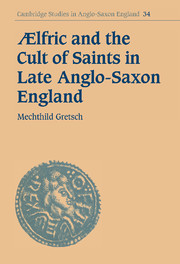Book contents
- Frontmatter
- Contents
- Preface
- List of abbreviations
- 1 Ælfric's sanctorale and the Benedictional of Æthelwold
- 2 Gregory: the apostle of the English
- 3 Cuthbert: from Northumbrian saint to saint of all England
- 4 Benedict: father of monks – and what else?
- 5 Swithun and Æthelthryth: two saints ‘of our days’
- 6 Epilogue
- Bibliography
- Index of manuscripts
- General index
4 - Benedict: father of monks – and what else?
Published online by Cambridge University Press: 22 September 2009
- Frontmatter
- Contents
- Preface
- List of abbreviations
- 1 Ælfric's sanctorale and the Benedictional of Æthelwold
- 2 Gregory: the apostle of the English
- 3 Cuthbert: from Northumbrian saint to saint of all England
- 4 Benedict: father of monks – and what else?
- 5 Swithun and Æthelthryth: two saints ‘of our days’
- 6 Epilogue
- Bibliography
- Index of manuscripts
- General index
Summary
It is not difficult to imagine what writing a uita of St Benedict will have meant to a Benedictine monk of the second generation of the tenth-century English reform, a monk moreover, who had been trained in the intellectual and political headquarters of the reform, the Old Minster at Winchester under Bishop Æthelwold. Benedict was of course the father of western monasticism. By the turn of the first millennium, however, he had long been established as one of the principal saints of Anglo-Saxon England. This much is attested, for example, by Ælfric's inclusion of a Life of Benedict in the Catholic Homilies, which contain uitae only of those saints who were venerated by all the English people (as distinct from the Lives of Saints, in which the sanctorale of monastic communities is represented); and the evidence of surviving calendars, litanies, hymnals and mass sets points in the same direction. The evidence of the calendars can be conveniently controlled in a recent publication by Rebecca Rushforth, where for each month of the year the contents of the twenty-six calendars and calendar fragments from Anglo-Saxon England are set out in tabular form. Of the three feasts of St Benedict (dies natalis 21 March, translation 11 July, (second) translation 4 December), that on 21 March is represented in all twenty-six calendars, the translation on 11 July is in twenty-four, and the translation on 4 December in fourteen calendars.
- Type
- Chapter
- Information
- Aelfric and the Cult of Saints in Late Anglo-Saxon England , pp. 127 - 156Publisher: Cambridge University PressPrint publication year: 2006



